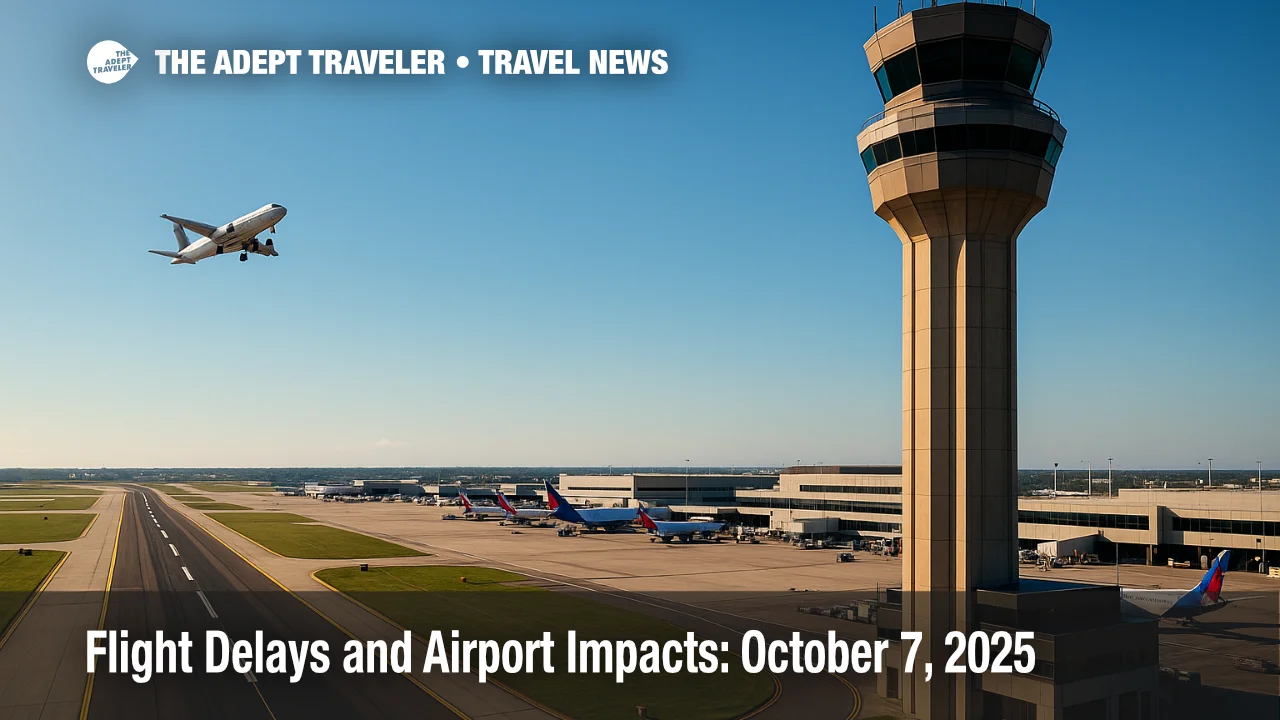Flight delays and airport impacts: October 7, 2025

A mix of staffing stress and thunderstorms drives today's plan. The FAA's morning operations outlook highlights potential ground stops or delay programs at Boston Logan International Airport (BOS) and Denver International Airport (DEN), with storms threatening Miami International Airport (MIA), Fort Lauderdale-Hollywood International Airport (FLL), Orlando International Airport (MCO), and Tampa International Airport (TPA). Chicago O'Hare International Airport (ORD) and Chicago Midway International Airport (MDW) are on coded-departure routes due to nearby convection, and select Atlantic oceanic routes are closed early for weather. Travelers should expect metering into Ronald Reagan Washington National Airport (DCA) during peaks.
Key points
- Why it matters: FAA planning calls out Boston Logan, Denver International, and Florida hubs for possible programs.
- Travel impact: Chicago O'Hare, Chicago Midway, and Northeast flows face reroutes; Florida storms could trigger pop-up stops.
- What's next: Afternoon webinar updates may firm up Boston Logan programs and Florida SWAP routes.
- Chicago O'Hare uses FCA flow tools; Atlantic L453 and L455 are closed until reassessment.
- Reagan National carries an arrival delay advisory for compacted demand.
Snapshot
As of late morning, the Air Traffic Control System Command Center (ATCSCC) lists no active Airspace Flow Programs, but multiple "planned" levers if weather underperforms. Boston Logan is "probable" for a ground delay program after the evening push, while Denver International may see a ground stop or delay program after early afternoon. Florida hubs, including Miami International and Fort Lauderdale-Hollywood after midafternoon, as well as Orlando International and Tampa International later, could move to coded-departure routes or SWAP escape paths if thunderstorms pulse along departure gates. Chicago O'Hare and Chicago Midway are already on CDRs with flow constraints to the southeast; two FCA initiatives funnel eastbound-to-O'Hare traffic. Atlantic routes L453 and L455 are closed for convection, with an update due midafternoon.
Background
Monday evening's most acute disruption centered on Hollywood Burbank Airport (BUR), where the FAA implemented a collaborative ground delay program amid a temporary tower staffing gap tied to the federal shutdown. The program averaged 151-minute delays, capped near 235 minutes, and ran through late evening while Southern California TRACON managed the airspace. While safety protocols kept operations orderly, the knock-on effect extended to departures and connections regionally. Today's national plan does not post a staffing trigger, but demand compression at peak banks, runway work at several major airports, and scattered storms in Florida and the Northeast mean reduced slack in the system. Expect modest buffers to erode quickly if convection intensifies.
Latest developments
FAA flags Boston Logan, Denver International risk; Florida storms could add CDRs and SWAP
The current operations plan sets the tone: Denver International faces a possible ground stop or delay program after 200 p.m. local, Boston Logan is "probable" for a ground delay program after 500 p.m. Eastern, and Florida hubs may escalate to CDRs or SWAP escape routes as convection builds late day. Chicago O'Hare and Chicago Midway remain on CDRs while two flow-constrained areas meter traffic into O'Hare from the east and southeast corridors. In the en-route picture, weather impacts span New York, Miami, Jacksonville, Memphis, Chicago, Kansas City, Houston, Fort Worth, and Albuquerque centers, with Atlantic routes L453 and L455 closed pending a 4:00 p.m. Zulu update. Expect additional transcon and Canadian routing initiatives into the evening if storms linger.
Analysis
Today's risk clusters around three nodes: Boston Logan runway configuration constraints during peak arrivals, Denver International's low ceilings, and Florida's storm-driven gate closures. If Boston Logan moves to a CDM ground delay, average delays often rise fastest during the late-day banks, especially if any runway work reduces arrival rates. Denver International's low ceilings tend to trigger short, choppy ground stops that convert to modest programs; watch for turn compression and taxi delays if ceilings hang on. In Florida, brief ground stops can ripple into rolling CDRs and SWAP routes, lengthening taxi-out and air times. Meanwhile, Chicago O'Hare's use of CDRs plus two FCA meters suggests the system is already squeezing throughput around Illinois convection. Add in published construction at Boston Logan, Orlando International, George Bush Intercontinental, Tampa International, Indianapolis International, Phoenix Sky Harbor, and San Francisco International, and the network has less flexibility to absorb surprises. For travelers, earlier departures, carry-on flexibility, and buffer time on Boston Logan-, Denver International-, and Florida-bound connections remain the smartest play. For broader context on shutdown-era pinch points at security and towers, see our explainer, Government shutdown travel: TSA warns of longer lines, and yesterday's wrap, Flight delays and airport impacts: October 6, 2025.
Final thoughts
Expect a two-wave day: modest midday holds around Denver International, then broader Northeast and Florida complexity as Boston Logan programs and SWAP routes firm up into the evening. If your itinerary touches Boston Logan, Denver International, Miami International, Fort Lauderdale-Hollywood, Orlando International, Tampa International, Chicago O'Hare, or the New York metro, build in connection buffers and monitor airline apps for gate or routing changes. Internationally, Atlantic route closures can add minutes to east-coast departures. We will watch afternoon advisories for any ground delay program confirmations and update if the plan shifts materially. Keep travel flexible, especially around the primary risk hubs listed in today's flight delays and airport impacts.
